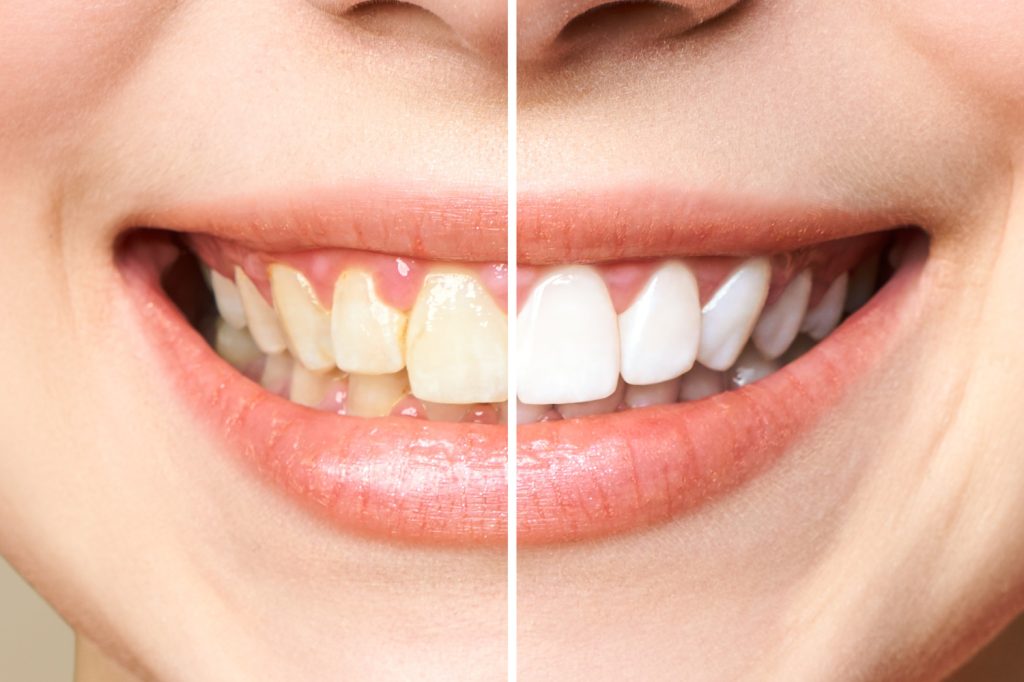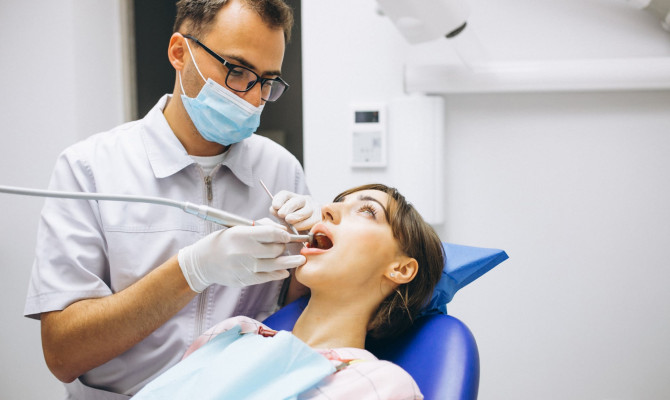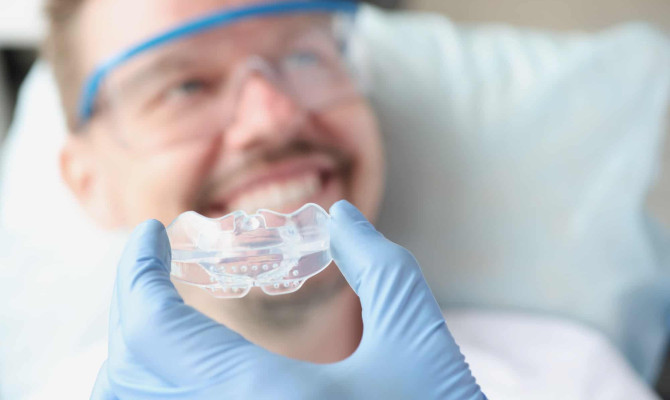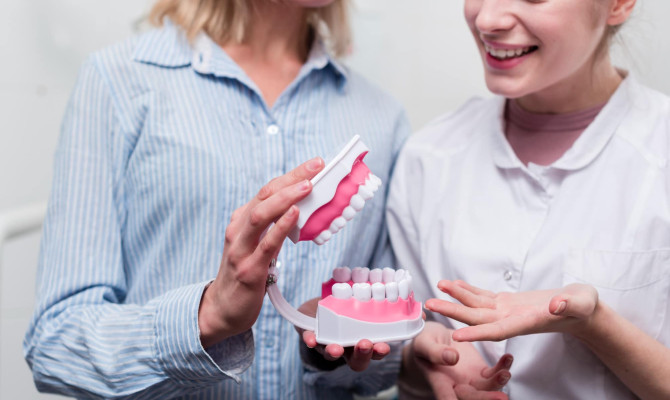Laser Gum Surgery: Indications, Procedure & Complications

- Gums
- 18 Sep 2023
Introduction
Laser Gum Surgery
In modern dentistry, technological advancements have revolutionized how we approach oral health and treatment. Among these innovations, laser surgery is a groundbreaking technique that has transformed the landscape of periodontal care. Our gums play a pivotal role in supporting healthy teeth and maintaining their well-being paramount for overall oral hygiene. Traditional gum surgery methods are effective but often involve invasive procedures with prolonged recovery time and potential patient discomfort.

In this article, we delve into the world of laser from surgery, exploring its principles, benefits, procedure details, and its comparison to traditional methods. Whether you are a patient seeking information about potential treatment options or a dental professional interested in staying at the forefront of periodontal care, join us as we uncover the intricacies and advantages of this surgery. 1 Introduction | Researched based study from National Institutes of Health
Benefits

Benefits of Laser Gum Surgery
- Precision
- Minimally invasive
- Faster healing
- Less amount of pain
- Lower risk of infection
- Minimal bleeding
- Preserves healthy tissue
- Requires less anesthesia
- Stimulates bone regeneration
Here is a brief detail about the points mentioned above:
Precision and targeting
- It allows for precise and targeted removal of diseased or damaged gum tissue while leaving healthy tissues untouched.
Minimally invasive
- Laser procedures are less invasive than traditional gums surgery, reducing patient bleeding, swelling, and discomfort.
Faster healing
- The focused energy of lasers promotes faster tissue regeneration and healing, resulting in quick recovery times.
Reduced discomfort
- They typically cause less pain and discomfort during and after surgery, making the experience more comfortable.
Minimal bleeding
- The quarter-rising effect helps seal blood vessels, leading to minimal bleeding during and after the surgery.
Lower infection risk
- The risk of postoperative infections is decreased by the high-energy laser beam’s efficient sterilization of the treatment area.
Preserving healthy tissue
- Selectively removes diseased tissue, preserving healthier gum than traditional methods.
Less need for anesthesia
- Some laser gum surgeries are less painful, allowing patients to undergo the procedure with minimal or no anesthesia.
Stimulates bone regeneration
- It can stimulate bone growth, helping resurrect bone tissue supporting teeth.
Precision in gum reshaping
- Additionally, it is used cosmetically to reshape irregular gun lines and enhance appearance. 1 Benefits | Researched based study from National Institutes of Health , 5 Benefits| Researched based study from Science Direct
Evolution
Evolution of Gum Surgery
- Early methods: Historical approaches to gum surgery involved invasive procedures.
- Advancements: traditional techniques gave way to minimally invasive methods.
- Introduction of lasers: Laser technology revolutionized gum surgery with Precision and efficiency.
It is also known as laser periodontal therapy, a modern dental technique where employees focus laser energy on various gum-related issues. This innovative approach has gained popularity due to its efficacy and health benefits. Dentists can perform different gum procedures with enhanced accuracy using lasers of specific wavelengths.
Indications
Indications for Laser Gum Surgery
When do you need Laser Gum Surgery?
- Gum disease
- Gum contouring
- Pockets reduction
- Biopsy
- Gum recession
- Peri-implants
- Frenectomy
- Abscess treatment
- Lesion removal
It is applied in numerous situations to deal with a variety of gum-related problems. Here are some examples of common uses for it:
Periodontal disease
- It is frequently treated with several methods’ gingivitis and more advanced stages like periodontitis.
- It helps remove disease tissue and bacteria from the gums.
Gum contouring and reshaping
- It can be used to cosmetically reshape the gum line. To make a smile look less gummy or to provide a more even and aesthetically pleasing gum line.
Gum pocket reduction
- In cases of deep gum pockets that are difficult to clean, the surgery can be employed to reduce pocket depth and facilitate better oral hygiene.
Biopsy procedures
- Dentists, and oral surgeons may use lasers to perform gum tissue biopsies, helping diagnose conditions like oral cancer or other oral lesions.
Treatment of gum recession
- It can be used to treat gum recession by promoting the regeneration of tissues or by covering exposed throats to protect them.
Treatment of Peri implants
- For patients with dental implants experiencing inflammation or infection in the surrounding gum tissue, laser gum surgery can help resolve the issue while preserving the implant.
Frenectomy
- In some cases, it is used to correct problems related to the frenulum, the tissue that connects the lips or tongue to the gums. This can be necessary for conditions like tongue tie or lip tie.
Abscess treatment
- Dental abscess, which are painful infections, can be treated with laser surgery to drain the abscess and promote healing.
Lesion removal
- Cancerous growth, lesions, or fibromas in the gum tissue can be removed with it.
Pain reduction
- It can be used to desensitize or reduce pain in specific areas. 3Indications| Researched based study from National Institutes of Health
Types
Types of lasers used in Laser Gum Surgery
Diode lasers
- Ideal for soft tissue procedures, the effective target gum tissues and promote tissue regeneration.
Nd:YAG lasers
- These can penetrate deeper into tissues and are often used for more advanced cases of gum disease.
Erbium lasers
- Offers precise control, they are used for both soft and hard tissue procedures, making them versatile tools in gum surgery.4Types| Researched based study from National Institutes of Health
Preparation
Preparing for Laser Gum Surgery
Initial consultation
- Before undergoing, the patient should schedule an initial talk with their dentist or periodontist. During this crucial appointment, several key steps are typically taken.
Medical history review
- In order to determine any underlying medical issues or drugs that can affect the treatment, the dentist will check the patient’s medical history.
Oral examination
- A thorough examination of the patient’s gums and oral health will be conducted.
- This helps the dentist identify the specific issue that requires treatment and determine if the surgery is the appropriate solution.
Discussion of a treatment plan
- Based on the examination, the dentist will discuss the proposed treatment plan, including the type of laser to be used, the expected outcome, and any potential risks or alternatives.
Financial considerations
- Patients will receive information about the cost of the procedure and any insurance coverage. Payment options and financing may also be discussed.
Addressing questions and concerns
- Patients are encouraged to ask questions and share concerns about the procedure or recovery process.2Preparation | Researched based study from Science Direct
Preoperative instructions
- Fasting: Patients might need to refrain from eating or drinking for a particular amount of time prior to surgery, depending on the type of anesthesia or sedative employed. This helps minimize the risk of complications during the procedure.
- Medication management: Patients may need to adjust their medication routine, especially if they take blood thinning medications. The dentist will guide the management of drugs leading up to the surgery.
- Hygiene and oral care: Patients are typically advised to maintain good oral hygiene by brushing and flossing as usual. They should avoid aggressive brushing or flossing in the surgical area.
- Arrangements for transportation: Patients may require transportation to and from the dental office the day of operation, depending on the type of anesthesia employed.
- Comfortable clothing: Wearing loose, comfortable clothing is advisable to ensure ease of movement and comfort.
Anesthesia in sedation options
- Local anesthesia is administered to numb the treatment area, ensuring patients don’t feel pain during the surgery while remaining fully conscious.
- For patients with anxiety or nervousness, oral sedation in the form of a prescribed medication can be taken before the procedure to induce relaxation.
- IV sedation is administered intravenously and provides depreciation, often used for Complex cases or highly anxious patients.
- In some cases, general anesthesia may be necessary, especially for extensive or multiple surgical procedures. This induces unconsciousness, and patients will not be aware of the surgery.2Preparation | Researched based study from Science Direct
Procedure
Steps of Laser Gum Surgery
Depending on the patient’s health and the kind of laser being utilized, several processes may be required. Nevertheless, a general description of the process typically includes the following:
Preparation
- The patient is positioned comfortably in the dental chair, and the treatment area is numbed.
- In gum assessment, the dentist uses Diagnostic tools to assess the extent of gum disease or the specific issue that needs treatment.
Laser application
- It will target and precisely remove the diseased gum tissue. This laser energy simultaneously sterilizes the area, reducing the risk of infection.
- In tissue reshaping in gum contouring or reshaping cases, the laser is used to scalp the gum line for improved aesthetics.
Blood vessel sealing
- The laser heat effectively seals blood vessels as it cuts, minimizing bleeding during and after the procedure.
Tissue stimulation
- Some lasers promote tissue regeneration by stimulating cells to heal and repair.
- Targeted tissue treatment, one of the key advantages is its ability to precisely target and remove only the deceased or problematic tissue while living healthy one intact.2Procedure| Researched based study from Science Direct
Post Operative Care
Recovery after Laser Gum Surgery
After undergoing the surgery, patients can facilitate a smooth recovery by following these guidelines:
- Oral hygiene: Maintain good oral hygiene by gently brushing and flossing while being careful around the surgical area. A specific mouthwash may be suggested by the dentist to aid with healing.
- Diet: For the first several days, adhere to a soft diet to prevent irritating the surgical site. Foods like yogurt, soup, and mashed potatoes are typically recommended.
- Avoid irritants: Refrain from smoking and consuming alcohol, as they can hinder healing and increase the risk of complications.
- Pain management: Over-the-counter or prescribed medications can help manage any discomfort.
- Ice packs: Intermittently applying ice packs to the face can help minimize swelling.
- Rest: By receiving lots of rest and avoiding strenuous activities in the initial postoperative period, you give your body time to recuperate.
- Elevate your head: Sleeping with your head elevator slightly can minimize swelling.
- Follow-up appointments: You will likely have an initial follow-up appointment within a week of the surgery. During this visit, assess your healing and remove any sutures if necessary.
- Subsequent appointments, depending on your case, additional follow-up appointments may be scheduled to monitor your gum health and track your recovery.
- Ongoing oral care: After the surgery, it is essential to maintain regular dental checkups and cleanings to prevent further gum issues.
By diligently following postoperative care guidelines, managing the discomfort, and attending scheduled follow-up appointments, you can optimize recovery and enjoy the benefits of improved gum health.2Post Operative Care| Researched based study from Science Direct
What to eat after laser gum surgery?
Following a dentist or oral surgeon’s instructions regarding your diet is essential. A liquid diet is recommended immediately after the laser surgery to minimize irritation.
Water:
- Stay hydrated by drinking plenty of water. This is crucial for the healing process.
Broth:
- Clear sodium broth can provide nutrients and comfort.
Smoothies:
- Blends of fruits like bananas, berries, and yogurt for a nutritious and easy-to-consume option.
Milkshakes:
- Opt for milkshakes or Protein Shakes to add nutrition.
- Avoid straws, as sucking can disrupt the healing process.
Applesauce:
- Smooth, unsuited Apple sauce can be soothing and nutritious.
Soups:
- Choose mild, lukewarm soups that are not too hot.
- Creamy or pureed soups like butternut squash, or tomato soup can be consumed.
Pudding and Jello:
- These are gentle on the mouth and gums and provide some variety in your diet and be a source of comfort.
Ice cream:
- In moderation, ice cream can be soothing and enjoyable.
Tea:
- Non-caffeinated herbal teas can help the throat and provide some variety.
Avoid irritants:
- Stay away from spicy foods and alcohol.
- Avoid anything with tiny seeds or chunks that might irritate the surgical area. 7Post Operative Care| Researched based study from National Institutes of Health
Soft foods:
- A diet of soft, easy-to-cheek foods to minimize irritation. Examples include mashed potatoes, cooked pasta, and tender meats.
Yogurt:
- Greek yogurt or regular yogurt is soft and nutritious.
Oatmeal:
- Cooked oatmeal cooled to a comfortable temperature can be satisfying.
Protein Shakes:
- Consider protein Shakes for smoothies with added protein powder to support healing. 7Post Operative Care| Researched based study from National Institutes of Health
Complications
Side effects of Laser Gum Surgery
- Infection
- Pain
- Swelling
- Bleeding
- Sensitivity
- Tissue damage
- Recession
- Allergic reactions
- Incomplete treatment
- Anesthetic complications
It is generally considered safe and has many benefits; like with other medical procedures, there are some dangers and problems. Prior to having the procedure, you must be aware of these. Here are a few of them in list form:
Infection:
- Although the laser sterilizing effect reduces the risk, there is still a slide chance of infection.
- Proper postoperative care and following your dentist’s instructions can help minimize this risk.
Pain and discomfort:
- While it is less painful than traditional methods, some discomfort or pain may still occur during and after the procedure.
- Pain medications that have been prescribed can usually handle this.
Swelling:
- It is a typical adverse effect following surgery, particularly laser surgery procedures.
Bleeding:
- While it often involves less bleeding than traditional methods, some may still occur. Your dentist will provide instructions on how to manage this.
Tissue damage:
- In rare cases, tissue damage can cause unintended harm to nearby tissues. This risk is minimized when an experienced and trained dentist performs the procedure.
Sensitivity:
- Some people may experience increased sensitivity or temporary changes in gums sensation after the surgery.
Recession:
- In some cases, gum recession may occur, mainly if the surgery involves reshaping the gum line.
Allergic reactions:
- Although uncommon, allergic responses might occur when certain materials used in the procedure, such as anesthesia or sterilization.
Incomplete treatment:
- The laser may not altogether remove all diseased tissue in more advanced cases of periodontal disease, necessitating additional therapies.
Anesthetic complications:
- While complications related to anesthesia are uncommon, they can occur.
- These may include allergic reactions, adverse side effects, or complications from pre-existing medical conditions. 6Complications| Researched based study from National Institutes of Health
FAQs
Laser Surgery-Frequently Asked Questions
Is laser gum surgery effective?
- Laser surgery can effectively address a range of gum-related issues when performed by a skilled and experienced dental professional. Its effectiveness can be seen in several key aspects.
Is laser gum surgery safe?
- A qualified and experienced dentist typically views laser gum surgery as safe. It has a long history of use and a strong safety record.
How long does it take for laser gum surgery to heal?
- The length of recovery following laser gum surgery might vary based on a number of variables, including the particular technique carried out, the scope of the therapy, and the unique patient features.
Will gums grow back after laser surgery?
- The goal is to remove or reshape diseased or damaged gum tissue to improve gum health or aesthetics.
- While it can stimulate tissue regeneration to some extent, it is essential to understand the gum tissue, once lost or removed, may not fully grow back in the same way that some other tissues in the body can regenerate.
Any feedback on this article?
 This Articles content was accurate
This Articles content was accurate Very Informative Article
Very Informative Article I have a question or a comment
I have a question or a comment
 This article contains inaccurate content
This article contains inaccurate content This article was not helpful
This article was not helpful I have a question or a comment
I have a question or a comment
We appreciate your helpful feedback!
Checkout our social pages
References
-
National Institutes of Health
Introduction | Benefits
-
Science Direct
Preparation | Procedure | Post Operative care
-
National Institutes of Health
Indications
-
National Institutes of Health
Types
-
Science Direct
Benefits
-
National Institutes of Health
Complications
-
National Institutes of Health
Post Operative care




































